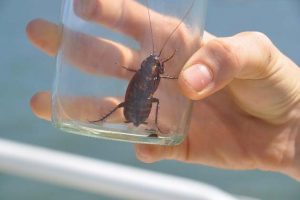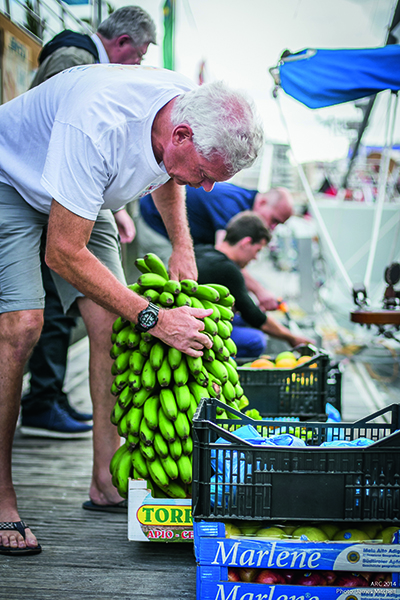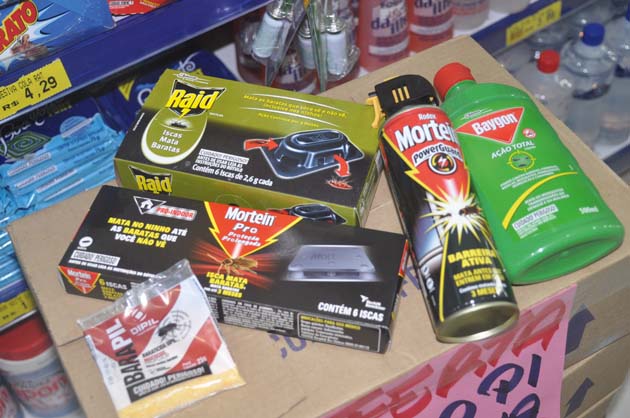As a long-term cruiser Jill Dickin Schinas knows what she’s talking about when it comes to bugs on board. She offers her advice on how to keep bug-free
A movement caught out of the corner of my eye: something furtive, small and fast. I must have imagined it, but I’ll have to take a closer look. Reluctantly, I peer into the ill-lit corner of my galley worktop; and there it is: shellac-coloured, half an inch long, blattella germanica is watching me.
“Roach!” I scream. Red alert, panic stations.
What is it about cockroaches that we absolutely cannot stand? Flies, mozzies, weevils… they all come aboard from time to time, and although none of them is remotely welcome it’s only the sight of a roach that sends cruisers into a tailspin. And they are, unfortunately, one of the hazards of long-term cruising.

The worst infestation I’ve ever heard of was suffered by a Canadian couple on their home-built gaffer. They had picked up their hitchhikers while moored alongside a quay in Brazil – and these were not the little bean-sized things that commonly infest yachts; they were the monsters that go scuttling across the pavement at night in the insalubrious quarters of any tropical town. These big roaches can fly, but happily rarely set up camp aboard a boat.
Cockroach fact: The female German cockroach carries her egg capsule inside her body until they are ready to hatch. If she dies prematurely her last act will be to eject that capsule with her latest batch of 40, which is why you won’t get rid of cockies in an afternoon. The unhatched eggs will continue to develop.
The commonest shipboard pest is the German cockroach – known in Germany as the Russian cockroach. It also has wings, but you won’t find it flying around your cabin because it has forgotten how to use them. And it breeds rapidly: a German cockroach and her young can produce 300,000 more roaches in a single year.
Ban the box?
According to accepted wisdom, roaches come aboard in the corrugations of cardboard boxes. But we have had cardboard boxes without cockroaches, and cockroaches without taking on board any cardboard. Personally, I think they arrive among the groceries.
Sometimes I scrutinise every packet of flour and peel the paper off every onion, but I’ve yet to uncover any of the enemy and the truth is that this a fool’s game. A cockroach’s egg case is tiny, and the baby bugs are absolutely minute.

According to the experts, roaches are also capable of hitching a ride from one territory to another by way of your bags and even your person. I’ve noticed that we almost invariably pick up roaches after a visit from someone who is already suffering an infestation. “Look out! Here come Eric and Susan. Stand by to fumigate them as they come aboard.”
Bombs away
In the bad old days the only cure for roaches was to ‘bomb’ the boat. When a charter yacht was suffering an acute infestation the crew would arrange for a two-day break between outings, remove all food and utensils from the galley, and then the pros would go aboard and set off foggers. These consist of aerosol canisters which fill the vessel with a poisonous mist.
Breathing in the mist can cause nose and throat irritation, dizziness, and vomiting; thus, after a bombing session no one is supposed to enter the premises again for several hours. But as we all know, roaches are more durable than mankind and the treatment often had to be repeated several times.
Nowadays we are even less eager to use chemical warfare. One approach to the roach family is to make friends with it. The most important thing when you sight one is to take action immediately, before things get out of control. A common recourse is to put down roach motels. These won’t cope with a full-scale invasion, but they might mop up the scouts.

The skipper traps a roach
When the motels don’t work, some people resort to purchasing squares of yellow paper. So far as I can see, these are sold for the specific purpose of parting the desperate from their money. The idea is that the roach is supposed to go skipping across the paper and stick to it. This doesn’t cure the problem, but when you’re fighting an infestation you’ll try anything.
Sell, sink or bomb?
After two years of sharing their home with an ever-increasing number of cockroaches, our friends Frank and Elise reckoned that they had three choices: sell the boat, sink her, or resort to the bombs. A safer method of administering the pesticide is to buy a Black Flag syringe filled with goo. You squirt the goo wherever you reckon the roaches are likely to go, they eat it and the colony dies out.
This stuff works. It may take a month, but if you keep at it, renewing the goo every week, you’ll eventually succeed. If you want to you can make your own goo, using boric acid and condensed milk. Boric acid is less toxic, but it can be hard to find.
Cockroach fact: Cockroaches are not a new problem; Columbus and Magellan suffered them too. According to legend, roaches became so abundant on long voyages, and food so scarce, that the insects began to prey upon the sailors. Some of the men even took to wearing gloves at night.
The safest and surest way to get rid of cockroaches is to go somewhere very cold. Insects don’t like sub-zero temperatures. Unfortunately, I don’t like them either and so we have used the second-best method, which is to starve them out and – just as important – to deny them access to water. Dry the sink and put in the plug; keep the galley scrupulously clean; put all food in boxes.
Even the fruit net is not out of their reach, so you’ll have to empty that, too.
Silverfish and weevils
Roaches aren’t the only critters that like sailing. Silverfish abound in our boat. They eat books and charts, but they do it very slowly and so we leave them in peace.

Silverfish insect, sometimes known as carpet sharks.
Weevils and flour moths are more of a nuisance. In fact, they’re much more destructive than cockroaches. Weevils eat rice and beans, and the moths spoil wheat-flour and biscuits. The best way to avoid the weevils is to buy your goods in tough plastic packets, and not loose.
As for the flour, a note I read on a brand of flour in Brazil read: ‘It is impossible to keep moth larvae, weevil eggs and lizard droppings out of this type of product.’ After a moment’s reflection I bought it anyway. Evidently this company doesn’t use pesticides.
The cure for an infestation of weevils and moths is to ditch any infected produce, clean the locker and keep your new stock in plastic containers – I use old fizzy drinks bottles. If this doesn’t do the trick, introduce a species of small spider to the locker. This is nature’s way of doing business, and it works.

Clover leaf weevil
Boats make cosy abodes. We even had a possum come aboard while we were anchored in the middle of a bay, and I recall reading about a man who opened his cockpit locker and found a fox curled up inside. A more frequent (but still very infrequent) visitor is a snake. The aquatic kind won’t come aboard, but if you spend time anchored on a river you might meet marsh snakes.
Less happy was the tale I heard of a chap who was alongside the bank taking on water. His first and last glimpse of a stowaway snake came as it slithered into the open hole into his tanks. What are a few hundred cockroaches compared to that?
How to cure the problem
The most radical treatment, of ‘bombing’ the boat, is not necessarily the most effective. This is because the poisonous fog doesn’t actually penetrate the places where the roaches hang out, behind your headlining and in the recesses of the deepest lockers.
Roach motels offer a less dramatic way to attack your unwanted guests. The original Roach Motel was designed to attract roaches, with either sweet-smelling food or pheromones, and to keep them there by the use of something ultra sticky. “They go in, but they don’t come out!” claimed the manufacturer, Black Flag.
Cockroach fact: Besides being capable of carrying such things as salmonella and dysentery, which arrive on their feet, cockroaches also leave faeces whose breakdown can trigger an asthmatic attack.
More common nowadays are motels that contain a poisonous food. The idea is that the roaches eat the food and then go home and die; and their kin subsequently eat them, and die; and so on, down the line. To be effective this kind of trap must be placed on the roaches’ habitual pathway – which will be along the sheltered, inner edge of the worktop, or at the edge of the floor. Moreover, there must be no competing food source; your galley must be spotlessly clean.
Wherever cockroaches abound you’ll have no trouble buying poisons with which to despatch them. These are usually to be found in the supermarket. Sprays are virtually useless. Wafting the stuff around will have little effect; to make a kill you will need to score a direct hit.

The useful shop-bought weapon is the poison-filled syringe. Also sold by Black Flag, they contain the same toxin (indoxacarb), but you can be more precise in your application. Again, for the stuff to be effective you need to know what route the insects are taking and ensure that no other food is available.
You can make your own DIY poisoned bait using boric acid and condensed milk. Apply this in the same way as the professional mix, via a syringe. For obvious reasons, you should not use this method if you have small children or sugar-loving pets. Boric acid can be difficult to find. In Spain and South America it is available in the bigger pharmacies.

Jill Dickin Schinas has been sailing all her life. She made her first ocean passage at 19 and has been living aboard boats ever since. In 1989 she and her husband-to-be set off round the world. She paints and writes features and books.
www.yachtmollymawk.com





 Cockroach fact: The female German cockroach carries her egg capsule inside her body until they are ready to hatch. If she dies prematurely her last act will be to eject that capsule with her latest batch of 40, which is why you won’t get rid of cockies in an afternoon. The unhatched eggs will continue to develop.
Cockroach fact: The female German cockroach carries her egg capsule inside her body until they are ready to hatch. If she dies prematurely her last act will be to eject that capsule with her latest batch of 40, which is why you won’t get rid of cockies in an afternoon. The unhatched eggs will continue to develop.